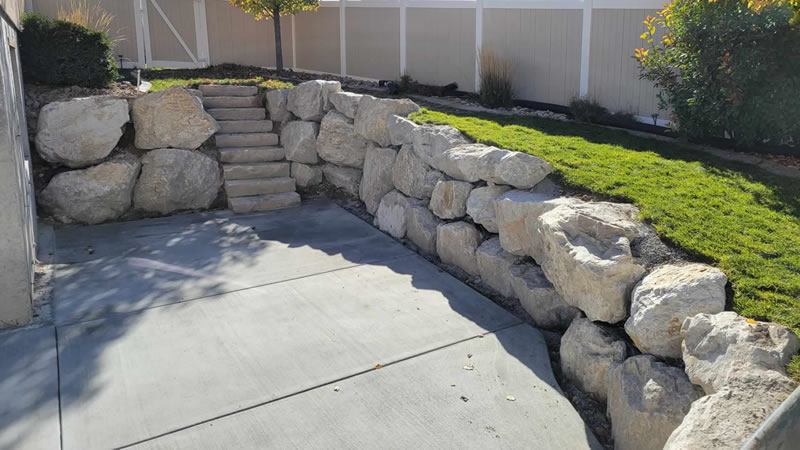Building a Boulder Retaining Wall: Everything You Need to Know
If you’re looking for a way to prevent erosion and hold back a slope on your property, while at the same time giving your property a great, natural landscaped look then building a boulder retaining wall may be the solution for you. But before you get started, there are some things you need to know about boulder retaining walls.
In this article, we will discuss the process of building a boulder retaining wall, from sourcing boulders to completing drainage work. We’ll also answer some common questions about this type of project. So if you’re thinking about building a boulder retaining wall, read on!
#1. Sourcing Local Boulders:
The first step in building a boulder retaining wall is to source the boulders. You can find boulders of varying sizes at local quarries or landscape supply yards (who will source them from a local quarry anyway). It’s best to have a local source to reduce the cost of transporting the boulders. Large heavy rocks are not easy to move.
It’s also important to make sure that the boulders are all somewhat uniform in size and shape so that they will stack and fit together nicely. Because large boulders are a naturally supplied element no two boulders will be alike.
Suppliers will have a variety of sizes available with 1′ to 2′ long boulders being on the smaller scale and boulders larger than 4′ would be considered “large”. They are generally sold and priced by the ton instead of per boulder.
#2. Site Preparation For A Boulder Wall:
The next step is to prepare the site where the boulder wall will be built. But before we get into that it’s important to consider the lay of the land on your property.
What are we dealing with for a slope and natural contours? A good landscape contractor with experience building boulder walls will be able to come up with a design that can take advantage of the existing topography. This will be beneficial if you wish to incorporate additional elements into the wall such as stairs, or a water feature, or a carved out area for a patio.
Another thing to consider will be if the wall is just a single layer of boulders or if they are going to need to be stacked or if the wall will be tiered. Stacking boulders requires heavy equipment and the construction of a tiered boulder wall can take a little more planning as the weight of the boulders and the setback from each tier needs to be carefully considered.
Site preparation for a boulder retaining wall can include excavating the area to the desired depth and width of the wall. The trench will need to be backfilled with the proper base materials which can vary depending on the quality and type of your existing soils.
If the wall is only one layer of boulders high then the initial course of boulders won’t need to be set into the ground very deep and in most cases can just be positioned on top of the ground. If the wall is going to be stacked, a tiered wall, or it will hold some type of surcharge (load) above the wall then setting the first course 1/3 to 1/2 the initial height of the first row of boulders will help stabilize the wall and prevent the wall from shifting.
#3. Drainage For Your Boulder Retaining Wall:
One of the most important aspects of building a retaining wall is to make sure that adequate drainage is provided. Gravity is constantly working against retaining walls and water is the main enemy.
One of the benefits to a natural boulder retaining wall is that because the rocks aren’t fit as tightly together as landscaping block they do have the ability to release water (hydrostatic pressure) from behind the wall out through the cracks between the boulders. This is actually not preferred though because it can cause soil erosion and cavities in behind the wall. The proper use of backfill behind the boulders can help direct water down to the base and into the ground.
Drainage is a really important (critical) part of any retaining wall design and should absolutely be considered when planning for and building your boulder retaining wall.
#4. Access To Your Property:
Boulders aren’t small! They are large, heavy, cumbersome, and not that easy to move. Access to your property is an important factor when building a boulder retaining wall. If the wall is being built in a backyard are we going to be able to access the area with machines? Typically a smaller excavator can handle smaller boulders (1′ to 2′ in size) but much larger boulders are going to need a bigger machine to move the boulders around and put them into place.
Things that can make access difficult:
- Narrow passages into the backyard
- Fences or gates in the way
- Established landscaping
#5. Placing The Boulders For Your Wall:
Once you have sourced the boulders and have them delivered to the job site and the site preparation is all complete it’s time to start placing them.
The most important part of this process is making sure that each boulder is placed in such a way that it fits nicely with the boulders on either side and will be stable and not move once the wall is complete.
This takes some careful consideration, planning, and usually a little trial and error too as we want to make sure that the wall looks as natural as possible. This is especially important if we are going for a stacked or tiered look.
#6. How Much Does A Boulder Retaining Wall Cost?
The cost of a boulder retaining wall will vary depending on a number of different factors as we’ve already discussed. If you just want some ballpark figures then $5000 at a minimum for a smaller single stacked wall around a garden or to surround a patio and all the way up to $100,000 or more for stacked or tiered walls that incorporate additional elements such as water features, stairs, or integrated patios.
The average cost for a boulder retaining wall would be between $10,000 and $35,000.
Remember, The size of boulder that you choose, the size and scale of the project, the amount of site prep work required, and the size of equipment required to complete the project are all going to effect the cost.
Natural boulder retaining walls can be one of the more expensive retaining wall options because of the equipment and labor costs but they can also be one of the most beautiful and long lasting options. It really depends on your budget and what you are looking for.
So there you have it! Everything you need to know about building a boulder retaining wall. As with any project, it is always best to consult with a professional before starting so that you can be sure to factor all of the important details into your design.
Who Builds The Best Boulder Retaining Walls In Salt Lake City?
SLC Lawn Services specializes in building boulder retaining walls throughout the Salt Lake City area. If you are interested in having a boulder retaining wall installed on your property, please give us a call (801) 637-8931! We would be happy to discuss your project with you and provide you with a free estimate.

